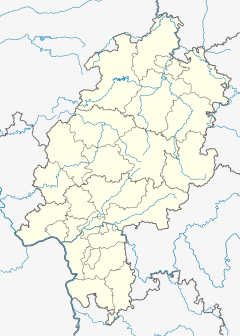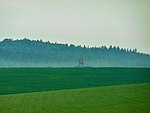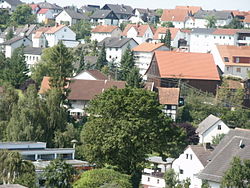Heenes
|
Heenes
City of Bad Hersfeld
Coordinates: 50 ° 53 ′ 32 " N , 9 ° 40 ′ 40" E
|
||
|---|---|---|
| Height : | 252 (232-305) m | |
| Area : | 1.91 km² | |
| Residents : | 1018 (December 31, 2004) | |
| Population density : | 533 inhabitants / km² | |
| Incorporation : | December 31, 1971 | |
| Postal code : | 36251 | |
| Area code : | 06621 | |
|
Location of Heenes in Hessen |
||
Heenes is a district of Bad Hersfeld , located in the Hersfeld-Rotenburg district in Hesse .
geography
Neighboring places ( clockwise ) are Tann and Rohrbach in the northeast, the Wehneberg in the east, Kalkobes in the southeast, Allmershausen in the southwest and Biedebach in the northwest. The municipality of Ludwigsau borders in the north. Heenes is 2/3 surrounded by forest; in the north-northwest rises the 448 m above sea level. NN high Haukuppe. In the southwest is the Hoherot at 325.9 m above sea level. NN .
The district can be reached via Kreisstraße 40, which branches off from Bundesstraße 324 between Bad Hersfeld and the Allmershausen district . The built-up area is 232 m above sea level. NN in the area where the Heenesbach flows into the Geisbach and rises to 305 m above sea level. NN on the slopes towards Haukuppe.
The Heenesbach rises above Heenes, flows through the place as watercourse III. Order and flows after 2 km between the Glimmesmühle and Kalkobes in the Geisbach .
history
The place is over 680 years old and was first mentioned in 1322 as villa Heynes (place on the grove ). The part of the name -hain suggests an earlier settlement in the period from the 8th to the 12th century. The settlement had developed around a feudal yard. The "Heeneser Mühle", a water mill, first mentioned in 1597, was used to grind the grain until the middle of the 19th century.
Between 1624 and 1626, 34 residents died of the plague . The population of Heenes decreased from 17 to 10 during the Thirty Years War . Eight farmsteads had become desolate.
The villages of Heenes, Kalkobes and Allmershausen initially used (since unthinkable times) the church and the burial place on the Frauenberg as part of the Hersfeld parish . It was not until 1912 that a separate cemetery was established in Heenes. Three Heenese school periods are historically documented: the first teacher was mentioned in 1722 (Hans Georg Lentz, who was also linen weaver), the second schoolhouse was opened in December 1839 and the third was inaugurated on September 8, 1952. Initially, church and school were spatially closely related: services were held in the schoolhouse. In 1952, the parish acquired the second school building that has now become vacant and was demolished in 1965. In the same year the new Protestant parish hall was inaugurated.
The shell limestone found in Heenes was processed into fertilizer lime and mortar in three lime kilns . The first lime kiln was mentioned in 1747. The historical locations of these systems were today's Ernst-Reuter-Straße 4, as well as the south side of the Ziegenrück. Another economic use of the shell limestone was the cultivation of lentils in Heenes. This may have led to the coining of the popular local names "Linseloch" or "Bad Lins".
Until the middle of the 19th century, the conifers growing around Heenes, especially spruce and pine, were used by local pitch- boilers to extract pitch . The pitch was used, among other things, to seal barrels. There was a kiln each 1.2 km northwest of Heenes and in the middle part of the Hottenbachtal. Resin was produced until 1955 .
A midwife , jointly committed by Heenes, Kalkobes and Allmershausen, was mentioned for the first time in a municipality bill in 1802. In 1845 the community of Heenes financed the training of its own midwife at the midwifery school in Marburg with 7 thalers .
The earlier traditional clothing of women is to be assigned to the Hersfeld costume . A special feature was the headgear with the pointed hood, which was called "Hubbeltracht". After the turn of the 20th century, headgear lost its importance and later there was a transition to urban fashion. In 1934, 48 of 184 women (26%) wore traditional costume. According to a report from 1879, the men's summer clothing consisted of a black cloth cap, a blue and white polka-dot scarf, a blue linen smock, black-striped cotton trousers and a linen shirt and shoes.
During the Seven Years' War (1756–1763) there were French troops in Heenes. In 1812 a Heeneser was killed in Napoleon's Russian campaign . Thirteen men of the village took part in the wars of liberation against Napoleon, one of whom fell in 1814. In 1866 a Heeneser went to war with Germany ; 1870–1871 three were in the Franco-Prussian War . In the First World War were 11 and in World War II to complain 35 casualties or missing. On March 31, 1945, the village was liberated from fascism by American troops .
At the height of a strike in the textile industry in 1958, violent verbal arguments broke out between those willing to work and those on strike. According to the police report, 250 to 300 people had jammed around an omnibus that was bringing strike-breaking textile workers to Heenes. The workers were then escorted to their apartments under police protection with drawn rubber truncheons.
In 1968 Heenes was the area winner in the competition: " Our village should be more beautiful ".
Originally independent, the municipality became a district of the district town of Bad Hersfeld on December 31, 1971 as part of the Hessian regional reform . The last mayor was Friedrich Sandlos, who did a great job building the church and the community center (built in 1965 as the most modern in the district at the time, renovated in 1997).
Heenes was included in the village renewal program of the state of Hesse in 1990, so that the architectural improvement of the public buildings, the canal and the road system were defining for the following decade.
On May 22, 2009, Heenes took part in the vote to move into the finals of the “ Dolles Dorf ” competition organized by Hessischer Rundfunk .
emigration
Valentin Hack, a soldier of Hersfelder Infantry Regiment Prince Charles, 1776-1783 as a result of soldiers trade under Landgrave Friedrich II. Of Hesse-Kassel at the American Revolutionary War took part, remained in the United States . Other Heeneser followed him in the mid to late 19th century, including to Vermilion in the US state of Ohio , a place that had had a German Protestant church since 1852 and had 275 inhabitants in 1860. The prevailing poverty is to be seen as an essential "push" factor of emigration: In 1846 the community of Heenes bought breadfruit from the Niederaula renting company for 52 talers in order to distribute it among the needy. The wave of emigration to America subsided after 1900, when the industry in Hersfeld experienced an upswing.
Population development
The population development of Heenes is shown in the table below. The data between 1930 and 1970 were collected in censuses, the data from 1997 come from the registration office.
| year | 1823 | 1840 | 1859 | 1867 | 1895 | 1930 | 1939 | 1950 | 1961 | 1970 | 1994 |
| Residents | 217 | 253 | 295 | 268 | 271 | 368 | 394 | 464 | 476 | 591 | 885 |
| year | 1997 | 2002 | 2004 |
| Residents | 978 | 951 | 1018 |
In 1859 Heenes had 295 inhabitants. One resident was blind, another was deaf and a third suffered from an intellectual disability . In addition to the plague, Heenes was affected by other epidemics : In 1902 three school children died of scarlet fever and in 1936/37 diphtheria developed .
Population, social affairs, economy
The structural structure of the place is characterized by the old village center, which is protected as a cultural monument and was gradually expanded by a new building area.
The functional center of the village is the community center, which was renovated in 1997, and the church in the center, which belongs to the Evangelical St. Matthew Congregation. Heenes has a municipal kindergarten and several playgrounds . Social life is shaped by several clubs : the Heenes sports club founded in 1907 , the Schützenverein 1897 e. V., the volunteer fire brigade and the VdK local association.
Heenes is predominantly the residence of commuters. Some part-time farmers , craft businesses, service providers and logistics companies are based on site.
politics
The local council was elected in 2011 with a turnout of 60% . The "Bürger für Heenes" (BfH) received 49.5% of the votes (4 seats), the SPD received 39.4% of the votes (4 seats) and the CDU 11.2% of the votes (1 seat) . Hans Werner Heyer was elected mayor. Martina Pfeffer (also BfH) was elected as deputy.
traffic
Heenes is integrated into the city bus system of the public transport system of the city of Bad Hersfeld, which in turn is connected to the North Hessian Transport Association (NVV). There is access to the ICE network of Deutsche Bahn via the Bad Hersfeld train station, which is 4 km away . Road traffic connections exist via the district road 40, the federal highways 324 , 62 and 27 , the motorways 4 and 7 . The Frankfurt airport is 152 km, Kassel-Calden (opened in 2013) 80 km away.
tourism
The forest and hiking trails leading around the district are particularly attractive for tourists. Northeast to find the village above the bunny hill to the forest (city wood) and west of the pine forest Heenes Bronze Age burial mounds . In districts 104 and 110 of the Heenes forest district are burial mounds from the younger Stone Age . Of particular geological interest is the Hersfelder Graben, a 110 to 460 m wide formation that starts from Heenes and is filled by shell limestone broken into red sandstone . Apartments and private rooms are available. Ahle sausage is one of the culinary specialties .
Drinking water and energy
The drinking water supplied to Heenes by the Bad Hersfeld municipal utility is in the hardness range 2 (corresponds to 15 ° dH). Photovoltaic systems contribute to the energy supply of the place. In the city forest adjacent to Heenes, a wind energy park with six wind turbines was built from 2014, although the citizens' initiative "Save the city forest", founded in 2013, had raised objections.
linguistics
According to the dialect classification according to Wiesinger, the dialect spoken in Heenes lies in the transition zone between North and East Hessian , which are both forms of the Lower Hessian dialect , which in turn can be assigned to Central German .
literature
- Karl Apel: Messages (Mis cells) by Heenes, Bad Hersfeld , Kassel, 2000, p. 495.
Web links
- Heenes. Historical local dictionary for Hesse (as of July 29, 2015). In: Landesgeschichtliches Informationssystem Hessen (LAGIS). Hessian State Office for Historical Cultural Studies (HLGL), accessed on September 9, 2015 .
Remarks
- ^ Federal Statistical Office (ed.): Historical municipality directory for the Federal Republic of Germany. Name, border and key number changes in municipalities, counties and administrative districts from May 27, 1970 to December 31, 1982 . W. Kohlhammer GmbH, Stuttgart and Mainz 1983, ISBN 3-17-003263-1 , p. 396 .
- ↑ Citizens' initiative "Save the city forest"











